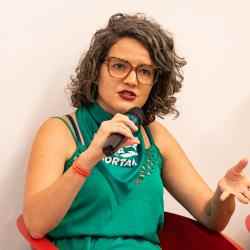Introduction
Brazil's more than 200 indigenous peoples are largely voiceless and suffer from the country's worst living conditions. They are often perceived by mainstream society as unusual, primitive, or violent. Vincent Carelli battles such prejudice and discrimination with Video in the Villages, a program that empowers indigenous peoples and changes mainstream societal perceptions.
The New Idea
Vincent recognizes the important role video can play in raising public awareness about indigenous issues throughout Brazil. He introduced video technology to indigenous communities in order to help them assert their cultural identities and preserve their traditions for future generations. These videos help shift public opinion and influence policies that affect these communities and their rights as citizens.Since oral traditions and storytelling are fundamental aspects of many indigenous cultures, video was quickly accepted by native communities as a powerful tool to transmit traditional knowledge and break stereotypes. Vincent s Indigenous Cinema School and the Video in the Villages (VNA) program trains indigenous people to produce audiovisual materials that empowers their communities and challenges misconceptions about nativesways of life. Vincent has distributed VNA films in their original languages with Portuguese subtitles and special educational manuals to indigenous schools as intercultural educational tools.VNAs work over the last 15 years has facilitated Brazilian indigenous groups to become acutely aware of the power of mass media and to shape the way they are depicted. For the first time in Brazilian history, a new public policy will give indigenous groups a space on public national television to broadcast their own programs. Vincent plans to create a national coalition of indigenous groups to make this initiative a reality.
The Problem
Indigenous communities in Brazil face challenges of identity, acceptance, and discrimination. Native peoples are trying to find ways to assert their identities in an increasingly globalized society and fight discrimination and marginalization. To be indigenous in Brazil often correlates with poverty and exclusion.Identity is at the center of most minorities struggles around the world. Gaining national visibility becomes politically strategic for such excluded populations. Most indigenous triumphs related to identity or rights have been accomplished through mass media exposure. However, indigenous peoples rarely have the resources to produce their own media or exercise control over how they communicate with mainstream society. New generations are moving toward mainstream culture to have access to new communication technologies and resist exclusion. In order to contribute to fields such as education, communications or the arts, communities need to gain control over their own portrayals in the mainstream media.Mass media tends to reinforce widespread prejudices of native backwardness,and portray them as victimized cultures doomed to becoming extinct. Moreover, the media often overlook diversity within indigenous populations and approach indigenous issues in simplistic ways. These prejudices are reinforced in Brazil s educational system. Instead of encouraging young generations to understand and respect cultural diversity, schools often teach children that indigenous peoples are homogenous, second-class citizens.Although specialists on indigenous issues have successfully created a space for themselves in public discourse, the indigenous themselves remain largely voiceless. Some of the people considered specialists by government authorities often fail to take the basic rights of indigenous communities into consideration. For example, a draft law that would authorize the involuntary adoption of indigenous children by non-natives is currently being debated. It is based on the argument that natives practice ritual infanticide, which is extremely rare today. As long as indigenous peoples remain voiceless, they will continue to be excluded from public debate and from decision-making processes that affect their lives. Indigenous cultures are studied by anthropologists, portrayed in the media, and discussed in public forums, but the people themselves are excluded from such forums. Thus, the conclusions reached about indigenous peoples are many times inaccurate.
The Strategy
Vincent created Video in the Villages in 1987 to empower indigenous populations to value their cultural heritage and be able to present themselves to Brazilian society (i.e. breaking down stereotypes and fostering tolerance). Vincent pioneered this effort in the midst of Brazils re-democratization process. The first to recognize the importance of the portrayal of indigenous communities in communication media, he began producing videos to dispel widespread stereotypes. Vincents early work with indigenous groups played an important role in pressuring the government to incorporate indigenous rights into the 1988 Constitution. As a result of this experience, Vincent realized the powerful impact of video media and founded VNA. In its infancy, VNA s videos were produced by Vincent and other non-indigenous filmmakers. However, he quickly understood that indigenous populations needed to become the producers of such videos if they were truly empowered and for mainstream Brazilian society to be adequately educated. The organization provides technical and financial resources to enable indigenous peoples to produce their own films. It also fosters the distribution of the videos among indigenous peoples, national and international media circuits, and the Brazilian educational system. Such dissemination has provided valuable windows into the lives and roles of indigenous populations. Through on-going, in-depth trainings, VNA offers high-quality audiovisual education in indigenous villages. The workshops instruct participants in script writing, filming, critical analysis of the recordings, and editing. The workshops interactive dynamics foster community participation at all stages of the process. After the courses, each participant develops a project, which receives VNA support and guidance, via the organizations production and distribution center. Video production, final editing, and distribution are led by the VNA office in Olinda, Pernambuco. VNA also provides new indigenous filmmakers with the necessary financial, technical, and content management skills.As a result of the trainings, VNA has produced more than 5,000 hours of video with approximately 40 indigenous peoples in 14 Brazilian states. Moreover, of VNAs 70 films, half were produced by indigenous authors. All videos are recorded in their original languages and are available with Portuguese, Spanish, English, and French subtitles.VNAs legal and financial structures significantly contribute to the empowerment of indigenous communities. Legal contracts guarantee the producers authorship rights and the filmed communities image rights. These contracts are established not simply for ethical reasons but to give indigenous communities ownershipof their personal image rights and their audiovisual work entitlements. Of the income generated from the sale of these videos 35 percent is distributed directly to the filmmaker; 35 percent to the community filmed; and the remaining 30 percent is invested back into VNA to train new filmmakers. VNA also uses video media as a political empowerment tool to advance indigenous rights. A 2006 production depicted the Iauaretê peoples waterfall as a sacred Heritage site, which contributed to the subsequent granting of the communitys land rights. In addition, the nationwide dissemination of videos depicting first contacts with native populations has influenced policy decisions, including a federal court s decision to protect an indigenous population in the state of Rondônia. This decision came at a time when landowners and even Brazils National Fund for the Advancement of Indigenous Peoples (FUNAI) refused to recognize the existence of the community. VNA films have also been used to settle conflicts among communities. For example, by sending audiovisual proof of the massive presence of gold prospectors on indigenous lands of the Nambiquara people, VNA was able to influence the delivery of a World Bank loan to the state government of Matro Grosso. In the end, the loan was conditional on the evacuation of gold prospectors from the area.Interactions such as these have promoted increasing exchange between indigenous peoples as well as changing the perception of mainstream society of indigenous life and impact. VNA videos are distributed to public television channels and are entered into high-profile national and international film festivals. They have been distributed to decision-making bodies at the local, state, and national level to force awareness of issues of indigenous rights and recognition. In partnership with the Ministry of Education and the Ministry of Culture, Vincent uses VNA materials to educate children in 3,000 public schools throughout Brazil about the life and rights of indigenous populations.Vincents work with government bodies has generated important results. In 1998, the Health Ministry contracted VNA s services to create special videos for the first national HIV/AIDS prevention campaign in indigenous areas. In 2000 Vincent partnered with the Ministry of Education to produce the series, Indians in Brazil for TV Escola, a national educational channel. This series was used as an educational tool in 50,000 public schools throughout Brazil. In 2002, in partnership with the Ministry of the Environment he used video as a tool to train indigenous people in the management of natural resources in the state of Acre. VNA has become a reference not only in the field of communication, but also in the field of indigenous rights. It has spurred the creation of similar initiatives on various continents and has received several national and international awards. Vincents efforts have led to the creation of the largest image archive on indigenous peoples in Brazil. Brazils Museu Dom Bosco recently created an indigenous audio-visual program with media from VNA s work. Today VNA is part of several native media networks, such as Native Networks (National Museum of the American Indian), CEFREC and Ojo de Aguain Latin America and Insuma TV, in the Inuit lands of Canada. Vincent is planning two new initiatives. First, he aims to diversify VNA s approach by introducing animation and Internet technologies in the creation of an indigenous news program. Vincent will use animation techniques to powerfully disseminate indigenous myths without relying on sophisticated special effects. He will broadcast real-time indigenous-produced news in all villages where VNA operates. Second, VNA will create a national coalition to oversee the implementation of a new public policy. For the first time in Brazilian history, a public television channel will be created for indigenous peoples to broadcast their own films, news and programs. Vincent wants to engage native groups from all regions of Brazil to own this process and to turn this opportunity into a reality. Such a public television channel will open a whole new set of possibilities for indigenous groups to challenge the way they are perceived and advance their rights.
The Person
When Vincent was 16 he visited a Xikrin village in the south of the state of Pará for the first time. He discovered that the world was much more diverse and fascinating than he had suspected. Vincent felt the need to share his experiences of this new world through visual mediums, such as photography. By the time he was 20, he had relocated to the Xikrin village and dedicated his time to working with and understanding indigenous cultures. Vincent later joined FUNAI to contribute to the advancement of indigenous rights. He quickly realized, however, that because the Brazilian government s authoritarian paternalism disarmed indigenous peoples politically, it could not be the driving force for change among that population. Rather, the responsibility rested with the individual indigenous communities and their collaborative fight for political rights.During the military rule in Brazil, Vincent worked with indigenous groups. He founded the Centro de Trabalho Indigenista (CTICenter for Indigenous Advocacy) with several colleagues. This was the first organization of its kind to challenge the states power over the natives. Vincent and his colleagues fought for basic rights, which years later were incorporated into the 1988 Constitution.Vincent later established an image bank for the series, Indigenous Peoples in Brazil, commissioned by the Center of International Law Studies. It was the first broad documentation of this sort in the country. He was enthusiastic about the opportunity to immortalize historical knowledge of indigenous populations for future generations. At the time, video was still a novelty, but once VHS camcorders were introduced, Vincent decided to create the Video in the Villages project within CTI. It was the product of his lifelong commitment to enable cooperation between natives and non-natives, to address issues such as land disputes, economic opportunities, and access to public health and education. VNA became an independent organization in 2000. VNA s work has been internationally recognized by numerous foundations, including early support from the Guggenheim, MacArthur, Rockefeller, and Ford foundations. From 1995, the International Cooperation Agency of Norway also funded their work, thus giving VNA greater stability, and enabling Vincent to design a long-term strategy. Today, the VNA stamp has become a national reference. VNA and the indigenous filmmakers have won several national and international prizes for their productionsempowering indigenous groups to envision and fight for their rights and freedoms.



